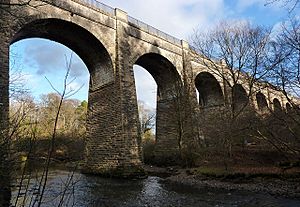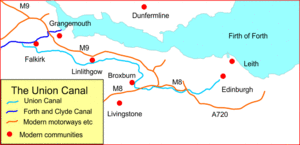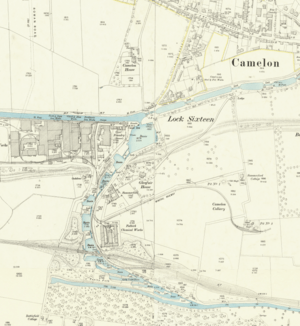Union Canal (Scotland) facts for kids
The Union Canal, also known as the Edinburgh and Glasgow Union Canal, is a waterway in Scotland. It stretches from Falkirk to Edinburgh. It was built to transport important materials like coal and other minerals to Edinburgh.
The canal first opened in 1822 and was very successful at the start. However, when railways, like the Edinburgh and Glasgow Railway, began operating in 1842, the canal became less important for transport. It slowly lost its commercial use and was officially closed for business in 1933. The canal was fully closed in 1965.
Today, the Union Canal is recognized as three separate historic sites by Historic Scotland. This is because it flows through three former areas: Midlothian, West Lothian, and Stirlingshire.
Thanks to a project called the Millennium Link, the canal was reopened in 2001. It was reconnected to the Forth and Clyde Canal in 2002 using the amazing Falkirk Wheel. Now, the Union Canal is a popular place for fun activities and leisure.

Contents
History of the Union Canal
Why the Canal Was Built
The idea for the Union Canal was to move minerals from mines and quarries in Lanarkshire to Edinburgh. This would make it easier and cheaper to transport things like coal and stone.
In 1817, a company called the Edinburgh and Glasgow Union Canal Company got special permission from the government to start building the canal. This permission came from a "Private Act of Parliament."
The canal was designed by Mr. Thomas Telford and Mr. Baird. They thought it would cost about £240,000 to build. Many people invested money in the project, including important figures like the Lord Provost of Edinburgh. However, the canal ended up costing more than expected, and the company had to get permission to borrow more money several times.
Some towns, like Linlithgow and Edinburgh, were worried the canal would make them lose money. They had roads where people paid tolls to use them. They asked the canal company to pay them back for any money they might lose because people would use the canal instead of their roads.
How the Canal Was Built
The Union Canal is about 31 miles (50 km) long today. It was built as a "contour canal." This means it follows the natural shape of the land. This helped avoid building expensive locks, which are like water elevators that raise or lower boats.
Because it followed the land, the canal needed large aqueducts to cross river valleys. Aqueducts are like bridges that carry water. The canal connected to the Forth and Clyde Canal near Falkirk and ended in Edinburgh.
The canal stays at the same height, about 73 meters (240 feet) above sea level, for almost its entire length. The original end in Edinburgh was at Port Hopetoun, but now it ends at Lochrin Basin in Tollcross.
The Union Canal has several impressive aqueducts:
- The Slateford Aqueduct carries the canal over the Water of Leith in Edinburgh.
- The Almond Aqueduct is near Ratho.
- The Avon Aqueduct near Linlithgow is 810 feet (247 meters) long. It's the second-longest aqueduct in the United Kingdom!
Many of the stone bridges along the canal have numbers carved into their keystones (the central stone at the top of an arch). The Viewforth bridge, near Edinburgh, even has the coats of arms of Glasgow and Edinburgh carved into its keystones.
The canal made money from tolls, which were fees paid to use the canal. The amount depended on how much cargo a boat was carrying. There were also fees for using the wharfs (loading and unloading areas).
The Canal's Decline and Closure
In 1842, the Edinburgh and Glasgow Railway opened. This railway took away most of the canal's passengers and much of its cargo. People who needed to transport goods quickly started using trains instead.
The railway company eventually bought the canal in 1849. The canal continued to carry industrial goods until after the First World War. However, when the main basins in Edinburgh (Port Hamilton and Port Hopetoun) closed in 1921, commercial use of the canal dropped even more.
In 1933, just over 100 years after it opened, the Union Canal was officially closed for commercial traffic. In the 1960s, the 11 locks at Falkirk that connected the Union Canal to the Forth and Clyde Canal were filled in. Parts of the canal were also covered over for new housing developments and for the M8 motorway. The canal was formally closed in 1965 and was left in poor condition for many years.
However, groups and local communities started a campaign to improve the canal. Work began in the 1990s to restore it. This led to the Millennium Link project, which reconnected the Union Canal to the Forth and Clyde Canal using the amazing Falkirk Wheel.
Millennium Link Project
The Millennium Link was a big project to bring the Union and Forth and Clyde Canals back together at the Falkirk end. In 2002, the Falkirk Wheel opened. This incredible boat lift reconnected the two canals, making history!
The project involved building new sections of canal, new locks, and even a short tunnel under the railway line and the ancient Antonine Wall. Several new bridges were also built. To design the curves for the bridge approaches, engineers even studied how large trucks turn, since there wasn't much computer information available for narrowboats at the time.
Fun Uses Today
Today, the Union Canal is used for lots of fun activities!
- People enjoy canoeing with the Forth Canoe Club.
- Students from schools and universities, like Edinburgh University Boat Club, go rowing.
- Groups like the Edinburgh Canal Society and the Linlithgow Union Canal Society help promote the canal. They rent out rowing boats and narrowboats, and they offer boat trips for everyone to enjoy.
- Re-Union Canal Boats is a group that builds and takes care of trip boats.
Scottish Canals, the organization that looks after Scotland's canals, has also improved the area at the Edinburgh end of the canal. This area, called Edinburgh Quay, now has apartments, offices, shops, and restaurants right by the water.
Raft races have also become a yearly event. People build rafts from "junk" materials and race them. The Linlithgow Union Canal Society has been holding its cardboard boat race for many years at Linlithgow Basin.
2020 Canal Breach
On August 12, 2020, heavy thunderstorms caused a lot of rain in eastern Scotland, including near Falkirk. This caused the Union Canal to overflow its banks east of Polmont. A large, 30-meter-wide hole, called a breach, opened in the canal's side. The floodwaters that rushed out caused a lot of damage to the main railway line between Glasgow and Edinburgh, which is Scotland's busiest railway line.






